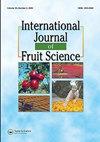Changes in Quality Traits and Phytochemical Components of Blueberry (Vaccinium Corymbosum Cv. Bluecrop) Fruit in Response to Postharvest Aloe Vera Treatment
IF 2.4
3区 农林科学
Q2 HORTICULTURE
引用次数: 6
Abstract
ABSTRACT The effect of Aloe vera application (33% and 66% as dipping, AV) on ‘Bluecrop’ blueberry’s (Vaccinium corymbosum) quality properties such as weight loss, respiration rate, fruit color, soluble solids content (SSC), acidity, phytochemical components (vitamin C, total phenolics, and total flavonoids) and antioxidant activity was investigated during the cold storage (at 0 ± 0.5°C and 90 ± 5% RH) for 28 days. During cold storage, significantly lower weight loss was recorded in fruit treated with AV compared to control. At the end of the cold storage, the weight loss was 20% lower in AV treated fruits and AV concentration was not effective in weight loss. On the contrary, the respiration rate (except for the 7th day) and fruit firmness were higher in these fruit. It was observed that color changes were less in AV-treated fruit during storage. In general, AV-treated fruit had significantly lower SSC, while acidity and vitamin C were higher. Moreover, 66% AV application was more effective in delaying the loss of vitamin C at the end of storage. During cold storage, 33% AV-treated fruit had significantly higher total phenolics (except day 28) and total flavonoids content compared to control. In the last two measurements of the cold storage, it was determined that fruit dipped in AV had higher antioxidant activity (both DPPH and FRAP assays) compared to control fruit. As a result, it was revealed that postharvest AV gel applications can be used as an effective postharvest tool to delay the loss of quality, the loss of phytochemical components and antioxidant activity of the blueberry fruit.蓝莓(Vaccinium Corymbosum Cv.)品质性状及化学成分的变化。采后芦荟处理对蓝作物果实的影响
摘要:在0±0.5°C、90±5% RH条件下冷藏28 d,研究了芦荟(33%和66%浸渍,AV)对蓝莓(Vaccinium corymbosum)失重、呼吸速率、果实颜色、可溶性固形物含量(SSC)、酸度、植物化学成分(维生素C、总酚类物质和总黄酮)和抗氧化活性的影响。在冷藏过程中,与对照相比,经AV处理的果实重量损失显著降低。在冷藏结束时,经AV处理的果实的减重率降低了20%,AV浓度对减重没有效果。相反,除第7天外,这些果实的呼吸速率和果实硬度都较高。在贮藏过程中,经av处理的果实颜色变化较小。总的来说,av处理的果实SSC显著降低,酸度和维生素C较高。此外,66%的AV应用更有效地延缓了维生素C在储存结束时的损失。在冷藏过程中,33% av处理的果实总酚类物质(除第28天外)和总黄酮含量显著高于对照。在冷库的最后两次测量中,确定了与对照水果相比,浸泡在AV中的水果具有更高的抗氧化活性(DPPH和FRAP测定)。结果表明,采后应用AV凝胶可以作为一种有效的采后工具,延缓蓝莓果实的品质损失、植物化学成分的损失和抗氧化活性的丧失。
本文章由计算机程序翻译,如有差异,请以英文原文为准。
求助全文
约1分钟内获得全文
求助全文
来源期刊

International Journal of Fruit Science
Agricultural and Biological Sciences-Agronomy and Crop Science
CiteScore
6.40
自引率
0.00%
发文量
64
审稿时长
10 weeks
期刊介绍:
The International Journal of Fruit Science disseminates results of current research that are immediately applicable to the grower, extension agent, and educator in a useful, legitimate, and scientific format. The focus of the journal is on new technologies and innovative approaches to the management and marketing of all types of fruits. It provides practical and fundamental information necessary for the superior growth and quality of fruit crops.
This journal examines fruit growing from a wide range of aspects, including:
-genetics and breeding
-pruning and training
-entomology, plant pathology, and weed science
-physiology and cultural practices
-marketing and economics
-fruit production, harvesting, and postharvest
 求助内容:
求助内容: 应助结果提醒方式:
应助结果提醒方式:


